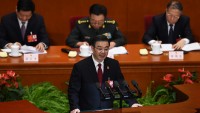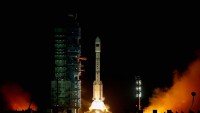China Develops World’s Longest-Range Missile that can hit US in Half an Hour
| J.B. Cach | | Mar 30, 2016 10:26 AM EDT |
(Photo : Jason Lee - Pool/Getty Images) In advancing its defense, China develops the world's longest-range missile.
China is currently within the final phase of testing the world’s longest range missile, which is believed to enter the service sometime this year.
The DF-41, hailed as the world’s longest-range intercontinental ballistic missile, is still undergoing some testing before it finally rolls out. It has an operational range of up to 14,500 kilometers and will be first deployed to the People’s Liberation Army’s new "Rocket Force” based in Xinyang, Henan province.
Like Us on Facebook
The report said that with the DF-41, China will be able to strike the United States within half an hour if the missile flies through the North Pole, or slightly longer than that if the missile cruises through the Pacific. However, defense analysts say it remains unclear if China’s longest-range missile will be able to penetrate the multilayered U.S. missile defense system situated in the Asia-Pacific.
China has tested the DF-41 for at least five times since 2014. It is also reported to be tested at the Taiyuan Satellite Launch Center in Shanxi province zone last summer.
Reports say that the DF-41 had been tested in various mobile launchers. On December 5, Chinese strategic weapons developers achieved a milestone by testing the DF-41 in railway-mounted mobile launchers, as well as road-based mobile launchers.
In addition to these developments, the DF-41 could see improvements in its strike rate within a few years should China complete its locally-made BeiDou navigation satellites, said Kanwa Asian Defence chief editor Andrei Chang. China will also be able to operate independently away from the U.S. global positioning system (GPS).
However, he added that the U.S. could develop technology capable of jamming BeiDou’s satellite signals.
In other missile defense news, the U.S. hopes to reach an agreement with China regarding a possible deployment of a U.S. Terminal High Altitude Area Defense (THAAD) system in South Korea.
This step, according to U.S. Deputy Secretary of State Anthony Blinken, is a necessary measure that the U.S. wants to take to protect both itself and its allied nations from North Korea’s missiles. Blinken added that as long as North Korea continues in their nuclear weapons development and testing, the U.S. will have to take necessary steps in ensuring its safety and that of its allies.
U.S. President Barack Obama is scheduled to meet South Korean President Park Geun-hye and Japanese Prime Minister Shinzo Abe to talk about North Korea’s nuclear weapons program. Talks between the U.S. and South Korea began after North Korea fired a long-range missile in February.
TagsDF-41, long-range missile, People's Liberation Army, THAAD, Beidou navigation system
©2015 Chinatopix All rights reserved. Do not reproduce without permission
EDITOR'S PICKS
-

Did the Trump administration just announce plans for a trade war with ‘hostile’ China and Russia?
-

US Senate passes Taiwan travel bill slammed by China
-

As Yan Sihong’s family grieves, here are other Chinese students who went missing abroad. Some have never been found
-

Beijing blasts Western critics who ‘smear China’ with the term sharp power
-

China Envoy Seeks to Defuse Tensions With U.S. as a Trade War Brews
-

Singapore's Deputy PM Provides Bitcoin Vote of Confidence Amid China's Blanket Bans
-

China warns investors over risks in overseas virtual currency trading
-

Chinese government most trustworthy: survey
-

Kashima Antlers On Course For Back-To-Back Titles
MOST POPULAR
LATEST NEWS
Zhou Yongkang: China's Former Security Chief Sentenced to Life in Prison

China's former Chief of the Ministry of Public Security, Zhou Yongkang, has been given a life sentence after he was found guilty of abusing his office, bribery and deliberately ... Full Article
TRENDING STORY

China Pork Prices Expected to Stabilize As The Supplies Recover

Elephone P9000 Smartphone is now on Sale on Amazon India

There's a Big Chance Cliffhangers Won't Still Be Resolved When Grey's Anatomy Season 13 Returns

Supreme Court Ruled on Samsung vs Apple Dispute for Patent Infringement

Microsoft Surface Pro 5 Rumors and Release Date: What is the Latest?














